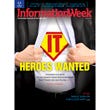Most employees outside of IT don’t call their IT teams very innovative, yet most believe technology is growing in importance, our research shows. Can IT still be the hero?
October 3, 2012

Remember when the IT department was the group that saved your bacon time and again? Computer crashes that everyone was convinced wiped out precious corporate data turned into miraculous recoveries. Critical applications that suddenly stopped working were just as suddenly revived. Even the ill-conceived, snarky "reply all" email that was deleted before corporate-wide distribution. Windows upgrades, network upgrades, database upgrades, everything upgrades were handled with aplomb.
What happened? We all know that the demands for IT have moved out of Fix It mode and into Innovation. Businesses need a new kind of IT hero. But when we asked 382 business pros--a mix of IT and non-IT people--about how IT is perceived in their companies, we were shocked by what we found in both the responses and the emotional comments that accompanied them.
The data shows a disparity between how IT views its performance (not bad) and how non-IT pros view it (not good). For example, asked if their companies' business users are at least moderately happy with the quality, timeliness, and cost of IT projects, two-thirds of the IT pros who responded to our survey said yes, but just half of non-IT pros said so. Asked if IT is foremost a support or maintenance organization (as opposed to the innovation engine it might want to be), 39% of IT pros agreed, but 54% of non-IT pros agreed. Again and again, the data shows a disturbing gap between IT's perception of itself as reasonably innovative and effective, and non-IT's lukewarm view.
As powerful as the data is, the free-form responses we received--and we got dozens of them--cast an even harsher light.
First, let's hear from the IT side, which had plenty of hero stories to relay.
"We brought 18 divisions (companies) under the same networks, interfacing at all levels from the top to the bottom. Wow, what a hurdle; these were all separate companies that were bought by my company. A major task."
How IT's Perceived By Business
 Get All Our Survey Data Free
Get All Our Survey Data Free
The data in this article comes from our 2012 IT Perception Survey of 382 business technology professionals.
This report includes all the IT Perception Survey data, including:
Comparisons of the 246 IT pros and 136 non-IT responses
Insight on IT's role in mobile policy and social strategy
Funding plans for innovation
Answered another: "We recently upgraded all our servers and desktops to virtualization and cloud computing. We needed more available space and were running out of room in our data center and server room. We also wanted a better way to control our storage and have better security. Our team of IT workers worked on this project day and night and weekends to make this project a success in a timely fashion with hardly any downtime or customer complaints."
Yet for every success story from the IT pros who responded to our survey, there were as many cutting comments describing the IT staff--even from IT pros themselves.
"Here, IT is seen as a drag on innovation. The user perception of IT is very low and generally this perception is ignored by senior IT management as not being of importance," said one respondent.
Said another: "Unfortunately, IT in our business is seen as a roadblock--users want to use personal devices, social networks, cloud services, etc.--and we often prevent that entirely or provide poor internal substitutes. We can't ever seem to coordinate upgrades on time. When I tell people what versions of Office, Web browsers, etc., I have to support, it's embarrassing!"
One sentence seems to sum up the scores of comments we received: "We are seen as a slow and bureaucratic organization."
The data puts an exclamation point on that last point: 57% of IT pros consider their organizations to be distributed, agile, and flexible; just 29% of non-IT pros do.
'More With Less' Isn't Enough
There's little debate that IT is a critical function. About 60% of both IT and non-IT pros say their internal IT team will be more important to the company in the next two years, and nearly all the rest say it will remain just as important as it is today.
So what's the source of this tension? Are IT organizations doomed to fall short of impossible expectations in this era of bring your own device, cloud computing, and software service vendors pitching business units with a fast install and end run around IT? Will IT's legitimate concerns about security, compliance, and integration make it the innovation villain, viewed as a drag on new corporate capabilities, rather than an innovation leader?
One argument is that IT has done too good a job in its cost-cutting role. A recent Gartner study showed that its record of doing more with less (a response found frequently in our study) makes IT a business segment leader in productivity. But while measuring IT largely on the "do more with less" criterion may warm the CFO's heart, it can run counter to the concept of implementing new technology to drive innovation.
"CIOs have made IT more efficient, with the result of devaluing IT as the returns on efficiency did not flow back to the source of those efficiencies in most organizations," says Gartner group VP Mark McDonald.
General Motors CIO Randy Mott put it this way, when addressing the InformationWeek 500 Conference last month in Dana Point, Calif.: "Businesses talk about their revenue and their costs, and they talk about their profits. IT is the area that has the most complexity, has the hardest work to do in a lot of cases, and all they get to talk about is costs. There's just something about that that just doesn't feel right."
It's why Mott requires a "revenue of IT" metric for every new IT project--business units, IT, and finance agree on that revenue-like value. At GM, Mott is trying to prove that the discipline companies demand for IT can co-exist with the need for rapid-fire innovation and new ideas. So some of GM's most innovative projects won't have a direct benefit but will proceed because business unit leaders say it's something the company or group needs. "The innovation is discretionary," Mott said. "That discretionary spend has to be evaluated like you look at other discretionary resources, like capital."
John Halamka, the CIO of Beth Israel Deaconess Medical Center, is taking a similarly disciplined approach to the problem of balancing innovation and tight budgets.
"Governance" was the emailed response from Halamka when I asked him the best way to make sure IT and business align for innovation. (Beth Israel Deaconess is the No. 1 company in the 2012 InformationWeek 500 ranking of business technology innovators.) The hospital group has committees in different areas that bring IT and business leaders together. "These committees are where I propose innovative tactics to accelerate business owner strategies," Halamka says.
I can hear the groans: Committees are the antithesis of innovation, no? However, innovation counts for little if it's not aligned with business objectives. The trick Halamka has mastered is creating a transparent committee where business priorities are developed and IT resources are matched to those goals. These leaders are working to formalize tech innovation as part of everyday business, because the reality is that business units aren't always going to ask for IT's help anymore.
End Run Around IT
The tension that comes through in our survey is about a lot more than budgets and governance. The less measureable but more emotional issue is IT losing its role as the source of the cool new technologies. "Sidestepping enterprise IT and using your own devices and applications is usually easier, more fun, and, let's face it, often cooler than using what the IT department doles out," Accenture writes in a recent study.
So even as technology innovation is seen as the driving force for companies (what is Google or Amazon or Facebook other than a technology engine underpinning a business strategy?), the people who should be empowered with the design, development, and care of that engine are seen--and often see themselves--as, well, slow and bureaucratic.
This split personality comes through in the survey. Only about a fourth of IT and non-IT pros say their organization is an innovation leader. When three-quarters of your employees consider your organization an also-ran in innovation, you have a problem.
Only 32% of the IT respondents think that IT plays an extremely important role in business innovation; only 25% of non-IT respondents think so.
One problem is that IT leaders, who should be trained, equipped, and ready to drive technology innovation, often aren't invited to the party. Allowing each company department to make its own tech decisions can quickly lead to a mishmash of social collaboration, CRM, analytics, and marketing tools and systems. GM's Mott acknowledges that rogue IT purchases and deployments are done to meet a pressing business need, but he also notes that not centralizing them squanders the chance to leverage the data or systems across the company. Other business units also don't have IT's experience vetting technology vendors and contracts.
"I see the decisions that people and companies make when they have no internal IT guidance, and it can be disastrous," says one respondent to our survey. "They fall prey to the latest fad or great salesman that comes along, and they end up with a mess and no one to help except the next salesman who comes along."
What would a more successful IT and business partnership look like? "Our IT team continues to be the filter and gatekeeper and rescuer regarding all things IT," says one of the more positive survey respondents. "We have several areas that work closely with us, and the amount of innovative and everyday work we can accomplish is tremendous."
Who's To Blame?
At too many companies in our survey, no one's in charge of innovation, there are scant funds to pursue it, and training is mostly do-it-yourself. But at least one survey finding is encouraging: Most respondents think business and IT departments are equally at fault for their dearth of innovation.
When we asked survey takers if their company "actively helps its IT professionals develop the business or soft skills needed to stay current and aid innovation," 55% of IT respondents said there's no formal program but they do what they can, and 22% have no program at all. Only 19% said their company has a program in place.
Dedicated IT funding for innovative new projects is scarce--only 13% of IT and 14% of non-IT respondents said their companies have such a fund. Similarly, 16% of IT respondents and 13% of non-IT respondents said such projects are a fairly easy sell despite no dedicated fund. The lion's share of respondents said funding is project-dependent (37% of IT and 29% of non-IT). However, a notably large percentage of respondents (24% of IT, 17% of non-IT) takes the dim view that projects take so many executive approvals that "by that time, they're no longer innovative."
IT Is In Demand
The idea that the IT organization is overlooked as an innovation driver and is being bypassed by business units comes at an odd time when you consider the robust employment prospects for IT professionals. Between 2001 and 2011, more than 742,000 new U.S. IT jobs were created, an increase of 29.1%, while employment as a whole grew just 0.2%, according to Bureau of Labor Statistics figures contained in a report by the Information Technology and Innovation Foundation. The report notes that the number of IT jobs has grown throughout the recent recession--6.8% from May 2007 to May 2011--as the U.S. job market shrank by 4.5%. At the same time, average IT worker salaries were 74% higher than the overall average. Offshore IT outsourcing hasn't displaced nearly as many American IT workers as critics have feared.
But make no mistake: IT pros must keep on evolving and adapting.

The biggest change is moving from being a service builder to a service integrator, as more of what IT provisions comes from cloud-based software, says Michael Skaff, CIO of e-commerce startup LesConcierges. Also a challenge is balancing corporate-wide computing requirements with requests from individual departments for rapid software implementation and BYOD, he says.
But Skaff's no stranger to using technology to drive cultural change. In his previous role as CIO of the San Francisco Symphony, he was instrumental in melding innovation within the conservative confines of a symphony hall. For example, instead of being steadfast about patrons turning off smartphones during a concert, those in the second level of the venue were encouraged to use Twitter and Facebook--with audio alerts turned off.
As other departments (most notably marketing) have embarked on technology strategies, the role of the CIO has also evolved into a collaborative and consulting role with those departments. "We are moving from classic design, develop, and deploy to collaborate, integrate, and secure," says Gregory Smith, CIO of The Pew Charitable Trusts and author of the CIO career guide Straight To The Top. In particular, the CIO should be involved in vendor selection based on criteria of security and corporate integration capabilities that a CMO might not consider.
As employees buy their own mobile devices, and cloud software runs in a vendor's database, these trends free IT from some of their duties of running--and fixing--day-to-day IT systems. Inside enterprise data centers, private cloud architectures are automating more work, also freeing IT pros up from manual tasks.
In a keynote speech at the InformationWeek 500 Conference, author and MIT professor Erik Brynjolfsson forecast a scenario where technology innovation will accelerate, replacing ever more human tasks and functions. While the idea of self-learning and self-healing systems has been around for a while, it's only now that those systems are leaving the R&D labs and entering the mainstream. The biggest threat to the traditional American IT employee won't be an offshore worker, Brynjolfsson said, but the very systems they're building and managing.
So how does IT move forward amid the uncertainty and doubt about its innovative firepower? That's one area where there's almost no debate in our survey. Nine out of 10 IT pros and non-IT pros either "completely agree" or "somewhat agree" that IT should work closely with business executives to develop innovative applications. That's a no-brainer, but companies doing it well are putting structures in place to make sure that cooperation happens.
The Innovation Blitz
Think about innovation, and you automatically think big insurance company, right? Probably not. But Allstate Insurance, under the office of its CIO, assigned Matt Manzella the job of chief innovation officer five years ago. (Just over one-fourth of companies in our survey have a chief innovation officer, and more than 70% of the time the role is part of IT.) "Innovation is less about traditional research and development and more about employee engagement," Manzella says.
Allstate runs what it calls "innovation blitzes." Manzella's innovation group works with a business unit to lay out a problem or opportunity, and then it's opened to employees, via an online forum, for ideas and discussion. Blitzes last about 10 days. The best ideas bubble up through voting and a high volume of comments. Business units and IT teams decide which to push into prototypes.
An Innovation Council consisting of top Allstate executives also reviews the results to see if the leading ideas have been adopted. There's even an Innovation Posse, which rounds up the good ideas that didn't make it to the top of the pack but are still worth exploring.
Allstate also stages hack-a-thons, known as Allstate App Attacks, four times a year whereby programmers working on new business systems on their weekends compete for prizes. With these techniques, Allstate collected 4,000 ideas from 20,000 employees in a year. It's implementing 100 of them.
Manzella, speaking at the InformationWeek 500 Conference, explained how one Blitz led to the development of a new process that steered claims around an adjuster if that person is unavailable. Allstate's innovation group produced a lightweight prototype, which the claims department helped to flesh out. Allstate, which implemented the process a year ago, estimates that it saved the company $18 million by reducing the time claims assigners and adjusters spend in meetings and reducing errors associated with claims processed after employee vacations.
Manzella offers three pieces of advice for developing innovation practices: Get top executives to buy in and participate; get business departments to do the same; and respond rapidly to comments and suggestions.
5 Next Steps
Help Your Tech Heroes Thrive
1. Take an honest assessment Is IT only the break-fix group that's called in for forgotten passwords? Or is IT expected to drive great things, with funding and training to support the mission? What are the examples that prove the innovation case? 2. Organize for success Think transparent, flat, and collaborative. Creative companies have set up processes for drawing ideas out of business units, often using online platforms to encourage corporate-wide, crowd-sourced innovation idea generation. 3. Create a realistic budget Whittling IT staff down until no one has time to do anything but put out fires is a fast way send tech leadership up in flames.
4. Train and educate What are the skills people need to spark technology innovation in your company? Business knowledge, communication, technical? Don't shuffle responsibility for training your organization out of IT's hands.
5. Celebrate the heroes IT pros can't wait to be called. They must be embedded in departments and interacting with customers to spot where technology can make companies better. And when you succeed, throw a party.
And as IT organizations look to drive innovation at their companies, be prepared for skeptics. That Allstate claims department with the $18 million savings? It was reluctant to even take part in innovation blitzes because it manages staff time closely to keep productivity high. Now the claims department runs blitzes under its own branding, Gold Mine.
You never know where the next great idea will come from. When Allstate did a blitz around its mobile app, it opened it up to about 5,000 people, producing 200 suggestions, from which 19 turned into actionable ideas that went on to the mobile app road map--including one from a top Allstate trial attorney in an office far from headquarters. "I guarantee you that guy's boss never said, 'Do you have any mobile ideas?'" Manzella says.
Mobility is one big reason the IT team at JPMorgan Chase got more aggressive with innovation. For example, Chase was among the first banks to let customers deposit a check by taking a picture of it with a smartphone. "We were bleeding edge, and that's something new for us," said Paul Heller, senior VP of the bank's corporate Internet group, speaking at the recent TechTomorrow IT leadership conference in Columbus, Ohio.
But Chase's IT team faced doubters when it first pushed the mobile agenda several years ago, when it suggested that the bank should offer text messaging for certain transactions. "Stupid idea" was the initial reaction from a business unit leader, Heller recalls. After some small experiments, which proved popular, that same skeptic is the biggest mobile advocate--and asking why the IT team can't move faster. Chase now has a dedicated strategy team that tracks trends in mobile payments and behavior, and takes those to business units where they work together on potential uses.
Today, it's the huge tech-driven opportunities that are creating the pressure on IT organizations, and the dissatisfaction. Line-of-business leaders see the chance to connect with customers better via smartphones or understand consumers better via high-speed analytics, but they aren't sure how to get there. The IT teams that help them get there will be on the fast track to hero status. --With Charles Babcock and Chris Murphy

InformationWeek: Oct. 15, 2012 Issue
Download a free PDF of InformationWeek magazine
(registration required)
About the Author(s)
You May Also Like







